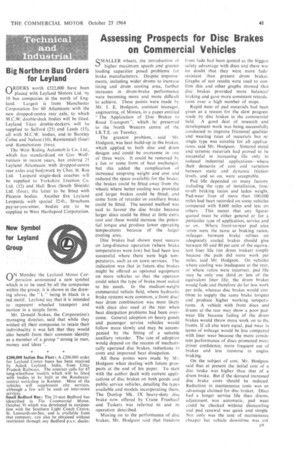Assessing Prospects for Disc Brakes on Commercial Vehicles
Page 43

If you've noticed an error in this article please click here to report it so we can fix it.
QMALLER wheels, the introduction of
higher maximum speeds and greater loading capacities posed problems for brake manufacturers.' Despite improvements, including wider drums'to increase lining and drum cooling' area, further increases in drum-brake performance were becoming more and more difficult to .achieve. These points Were made by Mr. T. E, Hodgson, assistant manager, engineering, of Mintex, in a paper entitled ." The Application of Disc Brakes to Road Transport ", which hc presented to the North Western centre of the f.R.T.E. on Tuesday.
The greatest problem, said Mr. Hodgson, was heat build-up in the brakes. which applied to both disc and drum designs and could be overcome in one of three ways.It could be removed by a fan or some form of heat exchanger. but this added the . complication of increased unsprung weight and cost and reduced the space available for the brake; the brakes could be fitted away from the wheels where better cooling was provided and larger . brakes could be fitted; and some form.of retarder or auxiliary brake could be fitted: The .secOnd method was said . to favour the disc brake because 'larger discs could be fitted at little extra cost and these would increase the potential torque and produce lower operating temperatures because of• the • larger
cooling area. . .
Disc brakes had shown most success on long-distance operation (where brake temperatures were low) but had been less successful where there were high temperatures, such as on town services. . The indication was that in future disc brakes might be offered as optional equipment On more vehicles so that the operator could select the type of brake most suited to his needs. In the medium-weight commercial vehicle field, where hydraulic brake systems were common, a front disc/ rear drum combination was most likely with discs also used at the rear when heat dissipation problems had been overcome. General adoption on heavy goods and passenger service vehicles would follow more slowly and may be accompanied by the fitting of a suitable auxiliary retarder. The rate of adoption would depend on the success of mechanically operated disc brakes, reductions in costs and improved heat dissipation.
All these points were made by Mr. Hodgson when dealing with future prospects at the end of his paper. To start with the author dealt with current applications of disc brakes on both goods and public service vehicles, detailing the types available and models incorporating them. The Dunlop Mk. IX heavy-duty disc brake now offered by Crane Fruehauf and Taskers was referred to and its operation described.
Moving on to the performance of disc brakes. Mr. Hodgson said that freedom from fade had been quoted as the biggest safety advantage with discs and there was no doubt, that they were more faderesistant than present drum brakes. Graphs of test results were used to confirm this and other graphs showed that disc brakes provided more balanced braking and gave more consistent retarda lions over a• high number of stops.
Rapid wear of pad materials had been, given as a reason, for the slow progress made by disc brakes in the commercial field. A good deal of research and development work • was being successfully conducted to improve frictional qualities and wearing rates of materials but nc single type was 'suitable for all applications: said Mr. Hodgson. -Sintered metal and ceramic materials had proved to be successful in increasing life only in isolated industrial applications—where their demerits of cost and variation between .static and dynamic friction levels, and so on, were acceptable.
Pad life depended on many factors, including the type of installation, foreto-aft braking ratios and laden weight. Pad-wear lives of more than 100,000 miles had been reciorded on some vehicles compared with 8,000 miles and less on others. This meant that any figures quoted must be either general or for a particular type of application, service and so on. Where front-to-rear pad area ratios were the same as braking ratios, mileages between brake. rdines on adequately . cooled, brakes should give between 60 and 80 per cent of the equivalent liner life (on drum brakes) simply because. the pads did more work per miles, said Mr. Hodgson. On vehicles where cooling was inadequate at the rear, or where ratios were incorrect, pad life maY be only one third or less of the equivalent liner . life; the drum brakes would fade and therefore do far less Work per mile, whereas disc brakes would continue to supply the same brake torques and produce higher Working ..temperatures. A vehicle with front 'discs and drums at the rear may show a poor padwear life because fading of the drum brakes would throw more work on to thc. fronts. If all else were equal, pad wear in terms of mileage would be less compared with finer wear because the more consistent performance of discs promoted more driver confidence, more frequent use of brakes and less recourse to engint braking.
On the subject of cost, Mr. Hodgson said that at present the initial cost of a disc brake was higher than that of a drum brake. But if the demand increased disc brake costs should be reduced. Reduction in maintenance costs was an advantage claimed for disc brakes. Discs had a longer service life than drums, adjustment was automatic, pad wear could be checked without dismantling and pad renewal was quick and simple. Not only was the cost of maintenance cheaper but vehicle downtime was cut




















































































































